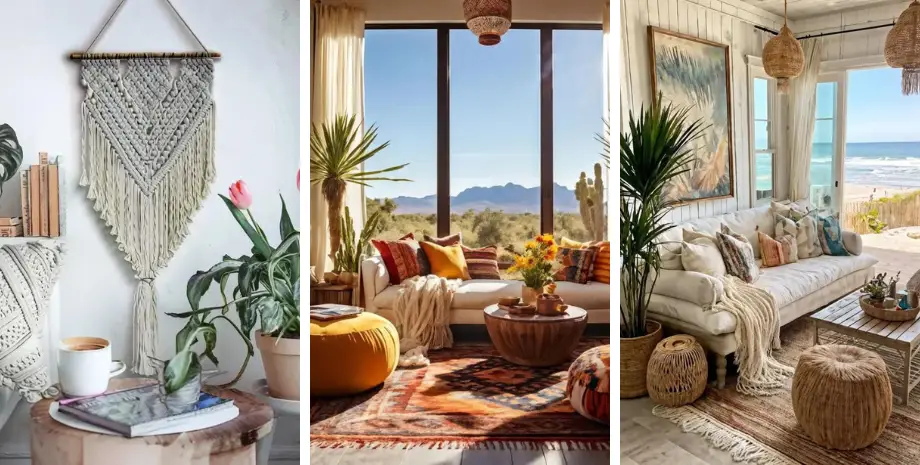When he first stepped into the room, he felt an immediate sense of calm wash over him. The subtle earthy tones, soft textures, and carefully chosen accents resonated with something deep within him. It wasn’t just a space; it was a reflection of who he was—free-spirited, grounded, and unafraid to mix the old with the new. The environment spoke to him, offering a sanctuary from the chaos outside.
As he settled into the low seating, surrounded by the intricate patterns and vibrant colors of the cushions, he felt a connection to something bigger. The blend of cultures and styles in the decor wasn’t just about aesthetics; it represented a way of life that valued diversity, creativity, and a certain kind of rebellious comfort. He could feel the history in the vintage furniture, the artistry in the macramé wall hangings, and the warmth in the fairy lights that softly illuminated the space.
This room had become his retreat, a place where he could let go of the day’s stresses and reconnect with himself. The carefully curated mix of textures, patterns, and natural elements was more than just decoration—it was a form of self-expression. Here, he could be himself, surrounded by the things that made him feel truly at home.
1. Layered Rugs





Layered rugs are a fantastic way to add depth and warmth to any space. By mixing and matching different textures, patterns, and colors, you can create a unique, cozy, and eclectic atmosphere. Here are some tips to make the most out of layered rugs:
- Start with a Base Rug: Choose a larger, neutral-toned rug as the foundation. This will ground the space and make it easier to layer more vibrant or patterned rugs on top.
- Play with Textures: Mix different textures like a soft wool rug with a jute or sisal rug. The contrast in textures will add visual interest and a tactile element to the room.
- Experiment with Colors and Patterns: If your base rug is neutral, consider adding a top rug with bold patterns or vibrant colors. If you prefer a more subtle look, stick with a monochromatic palette, using various shades of the same color.
- Vary the Sizes: Layer rugs of different sizes to create a dynamic look. A smaller accent rug on top of a larger one can highlight a specific area, like under a coffee table or at the foot of a bed.
- Overlap for a Casual Look: For an eclectic, laid-back vibe, allow the rugs to overlap slightly. This adds a relaxed, effortless feel to the room.
- Consider the Room’s Functionality: Think about the purpose of the room and the foot traffic when layering rugs. Ensure the rugs are securely in place to avoid tripping hazards.
- Seasonal Switches: Layering rugs also allows you to easily switch up the look of your space for different seasons. A cozy, fluffy rug can be added in the winter, while a lighter, flatweave rug can be perfect for summer.
By thoughtfully layering rugs, you can effortlessly transform your space into a cozy and stylish retreat.
2. Macramé Wall Hangings


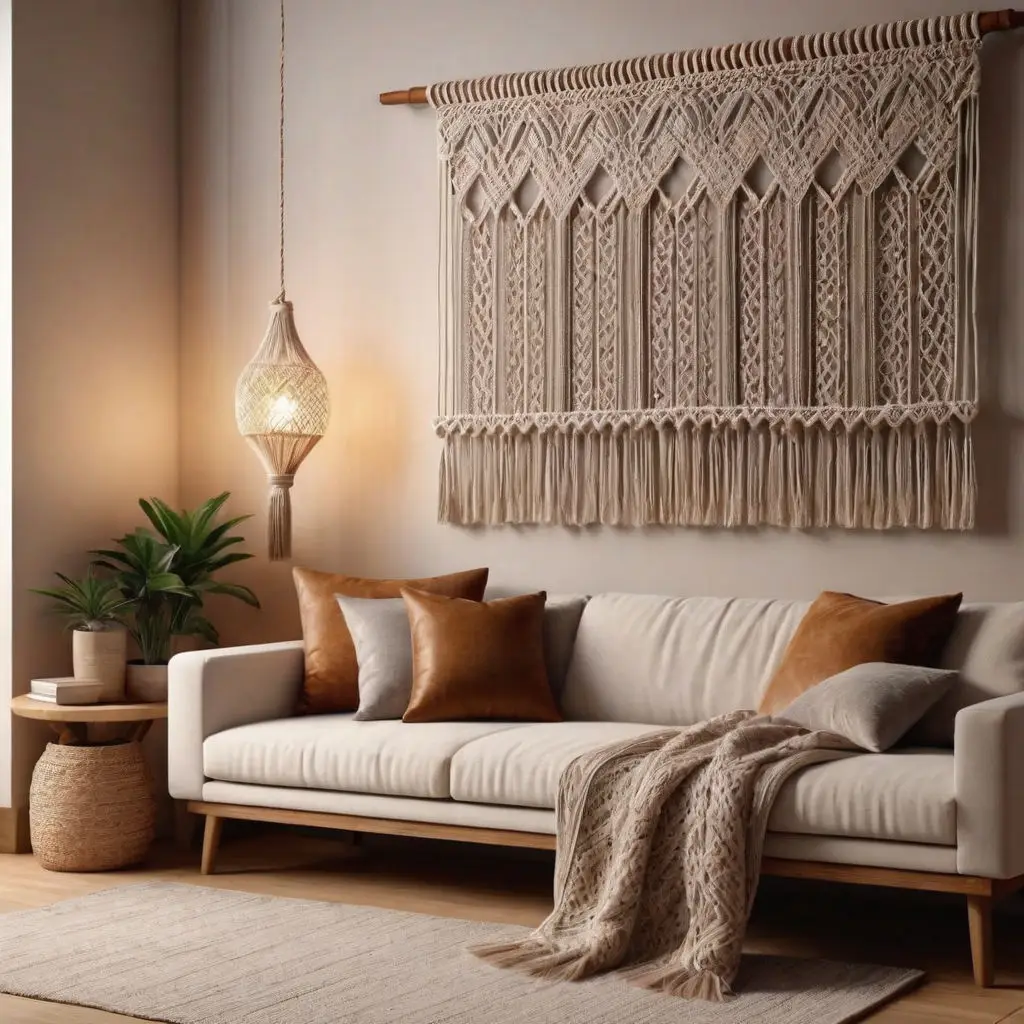


Macramé wall hangings are a beautiful way to introduce bohemian craftsmanship into your home decor. These handcrafted pieces add texture, warmth, and a touch of artistry to any room. Here’s how to incorporate macramé wall hangings into your space:
- Choose the Right Spot: Macramé wall hangings work well as focal points in living rooms, bedrooms, or even entryways. Consider placing them above a bed, sofa, or console table to draw the eye.
- Play with Sizes and Shapes: Macramé wall hangings come in various sizes and shapes, from small, delicate pieces to large, statement-making designs. Mix and match different sizes to create an interesting gallery wall, or opt for a single large piece for impact.
- Color and Material: While natural, off-white macramé is classic, you can also find or create pieces in various colors to match your decor. Some hangings include wooden beads, feathers, or other embellishments for added texture and interest.
- Layer with Other Decor: Macramé wall hangings pair beautifully with other bohemian elements like woven baskets, plants, or framed prints. Consider layering them with other wall art for a curated, collected look.
- DIY for a Personal Touch: If you’re feeling crafty, you can make your own macramé wall hanging. This allows you to customize the size, pattern, and color to perfectly suit your space.
- Lighting Considerations: To highlight the texture and craftsmanship of your macramé wall hanging, consider placing it near a light source. Soft lighting can cast interesting shadows and bring out the intricate details of the piece.
- Mix with Modern Elements: Macramé wall hangings don’t have to be confined to bohemian-style homes. They can also add warmth and texture to more modern or minimalist spaces, providing a nice contrast to sleek furniture and clean lines.
By adding macramé wall hangings, you can easily infuse a sense of handmade artistry and bohemian flair into your home, creating a cozy and inviting atmosphere.
3. Vintage Furniture




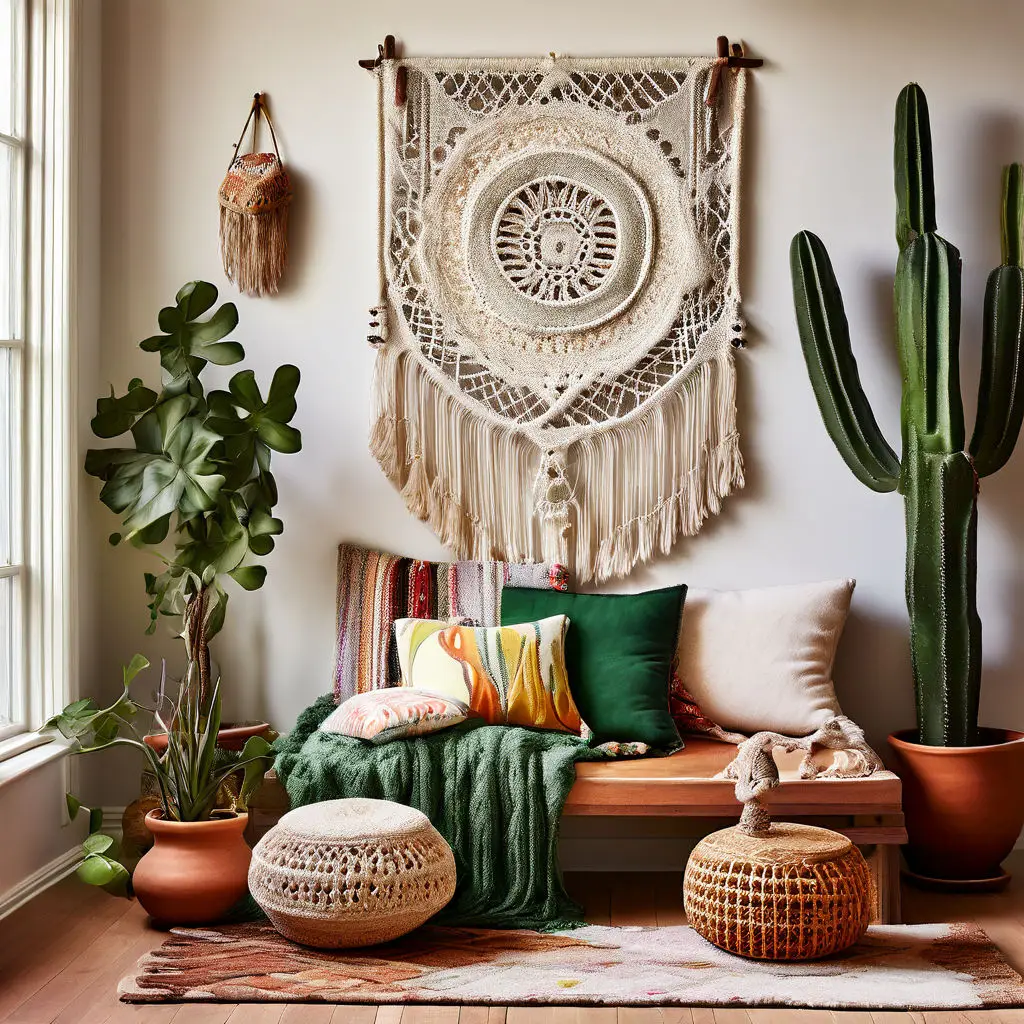
Incorporating vintage or distressed furniture into your decor can create a charming, relaxed atmosphere that feels both welcoming and uniquely yours. Here’s how to effectively use vintage furniture in your space:
- Mix and Match: Combine vintage pieces with modern furniture to create a balanced look. For instance, pair a vintage armchair with a contemporary sofa, or mix a classic wooden dining table with modern chairs.
- Emphasize Unique Features: Highlight the distinctive characteristics of vintage furniture, such as ornate carvings, patina, or unusual shapes. These details can add character and a sense of history to your space.
- Create a Focal Point: Use a standout vintage piece, like an antique sideboard or a distressed coffee table, as a focal point in a room. This can draw attention and set the tone for the rest of the decor.
- Blend Styles: Vintage furniture often comes in various styles, from mid-century modern to shabby chic. Don’t be afraid to mix different styles as long as they complement each other. This eclectic approach can create a visually interesting and dynamic space.
- Incorporate Accessories: Add vintage accessories, such as old books, retro lamps, or antique frames, to enhance the overall vintage vibe. These small touches can tie the look together and make it feel cohesive.
- Consider Functionality: Ensure that vintage furniture pieces are functional and comfortable. Sometimes, these pieces may need refinishing or reupholstering to fit your needs while maintaining their charm.
- Use Distressed Pieces: Distressed furniture can add a relaxed, lived-in feel. Look for pieces with a weathered finish or patina that blends seamlessly with your decor.
- Mix with Contemporary Elements: To avoid a room feeling too dated, balance vintage pieces with contemporary elements like modern artwork or sleek lighting fixtures.
- DIY Projects: If you enjoy DIY, consider giving an old piece of furniture a new life with a fresh coat of paint or a new set of hardware. This allows you to customize the piece to fit your space while preserving its vintage charm.
By thoughtfully incorporating vintage or distressed furniture, you can create a space that feels both timeless and inviting, with a relaxed and personalized touch.
4. Mix Patterns and Textures





Mixing bold patterns with soft textures is a fantastic way to create a rich, boho aesthetic in your home. Here’s how to blend patterns and textures effectively:
- Start with a Neutral Base: Use neutral-colored walls and larger furniture pieces to provide a balanced backdrop. This allows the patterns and textures to stand out without overwhelming the space.
- Layer Patterns: Combine different patterns like tribal prints, geometric designs, and floral motifs. Ensure they share a common color palette to keep the look cohesive. For example, mix a tribal print rug with geometric throw pillows, using colors that complement each other.
- Play with Textures: Pair soft textures such as faux fur, velvet, and knitted fabrics with your bold patterns. For instance, a velvet sofa can be complemented by a tribal print throw and a faux fur rug.
- Use Patterned Accents: Introduce bold patterns through smaller accents like throw pillows, rugs, or curtains. This prevents the space from feeling too busy while still adding visual interest.
- Create Contrast: Mix different textures to create a contrast between soft and tactile elements. A velvet armchair next to a woven rattan coffee table or a faux fur throw on a patterned sofa creates a dynamic, layered look.
- Balance the Scale: When mixing patterns, balance the scale of the patterns. Pair larger, bolder patterns with smaller, more intricate ones to avoid clashing and maintain harmony.
- Add Natural Elements: Incorporate natural materials like wood, plants, and wicker to ground the space and complement the boho vibe. These elements add warmth and contrast to the mix of patterns and textures.
- Experiment with Color: Use a cohesive color scheme to tie together different patterns and textures. Earthy tones like terracotta, mustard, and deep greens often work well in a boho setting.
- Consider Proportions: Be mindful of proportions when layering textures. For example, a large, plush velvet ottoman can balance out smaller, patterned throw pillows.
- Mix and Match Rugs: Layering rugs with different patterns and textures can add depth to a room. For example, place a tribal print rug over a larger, neutral area rug to create a stylish and cozy effect.
By thoughtfully mixing bold patterns with various textures, you can achieve a boho aesthetic that feels both eclectic and inviting.
5. Potted Plants




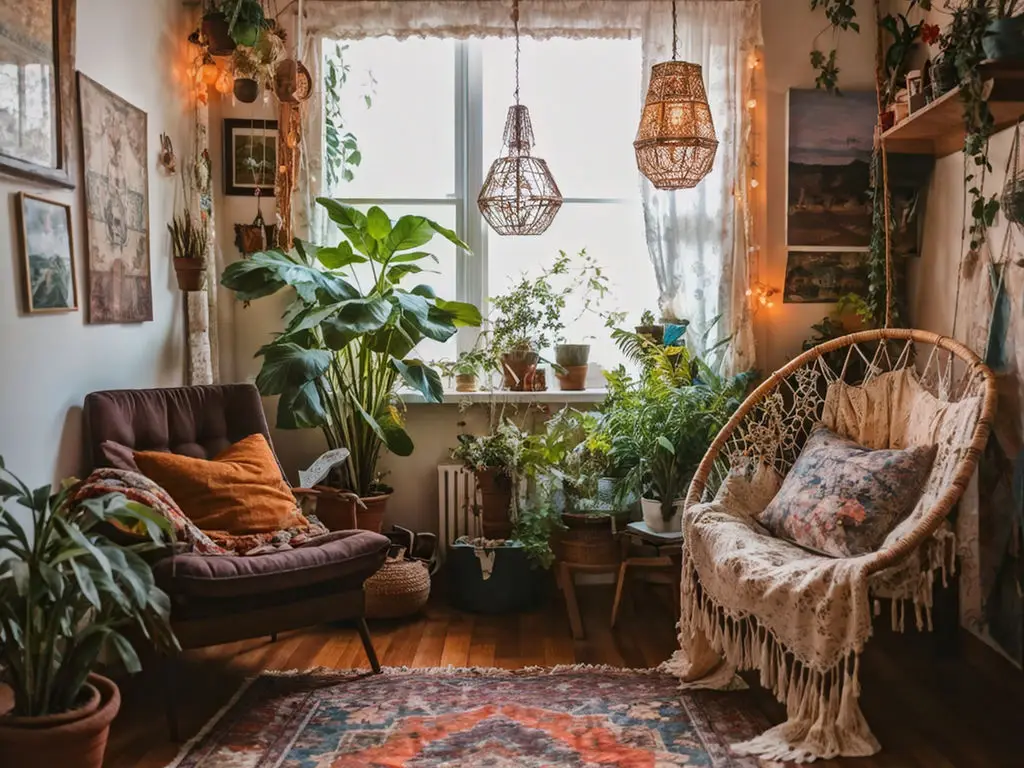
Incorporating potted plants and hanging greenery into your decor can infuse your space with a fresh, earthy vibe. Here’s how to effectively use plants to enhance your indoor environment:
- Choose a Variety of Plants: Mix different types of plants to create visual interest. Combine tall, leafy plants like fiddle leaf figs or monstera with smaller plants such as succulents or pothos.
- Use Different Planters: Select a variety of planters to add texture and style. Opt for sleek ceramic pots, rustic terracotta, woven baskets, or modern metallic finishes. Each type of planter can contribute to the overall aesthetic.
- Create a Plant Wall: Arrange multiple potted plants on shelves or wall-mounted planters to create a lush, green backdrop. This can serve as a stunning focal point and bring a sense of nature indoors.
- Hang Greenery: Use hanging planters or macramé plant hangers to add greenery at different heights. This can help utilize vertical space and create a cascading effect.
- Group Plants Together: Arrange plants in clusters to make a bigger impact. Group plants of varying heights and textures for a dynamic and natural look.
- Consider Plant Care: Choose plants that suit your light conditions and care preferences. Low-maintenance plants like snake plants, ZZ plants, or pothos are great for beginners or busy spaces.
- Add Plant Stands: Use plant stands or risers to elevate some plants and create layers. This helps to highlight different plants and makes them more visually appealing.
- Incorporate Planters into Furniture: Integrate plants into your furniture design, such as using plant shelves, built-in planters, or even turning a coffee table into a mini indoor garden.
- Use Plants to Define Spaces: Place taller plants in corners or near entryways to define different areas of a room. This can help create zones and add structure to open-plan spaces.
- Rotate Plants for Freshness: Periodically rotate your plants or switch them out for different varieties. This keeps your decor feeling fresh and dynamic.
By incorporating a variety of potted plants and hanging greenery, you can create a serene, organic atmosphere that enhances the beauty and ambiance of your space.
6. Moroccan-Inspired Accents




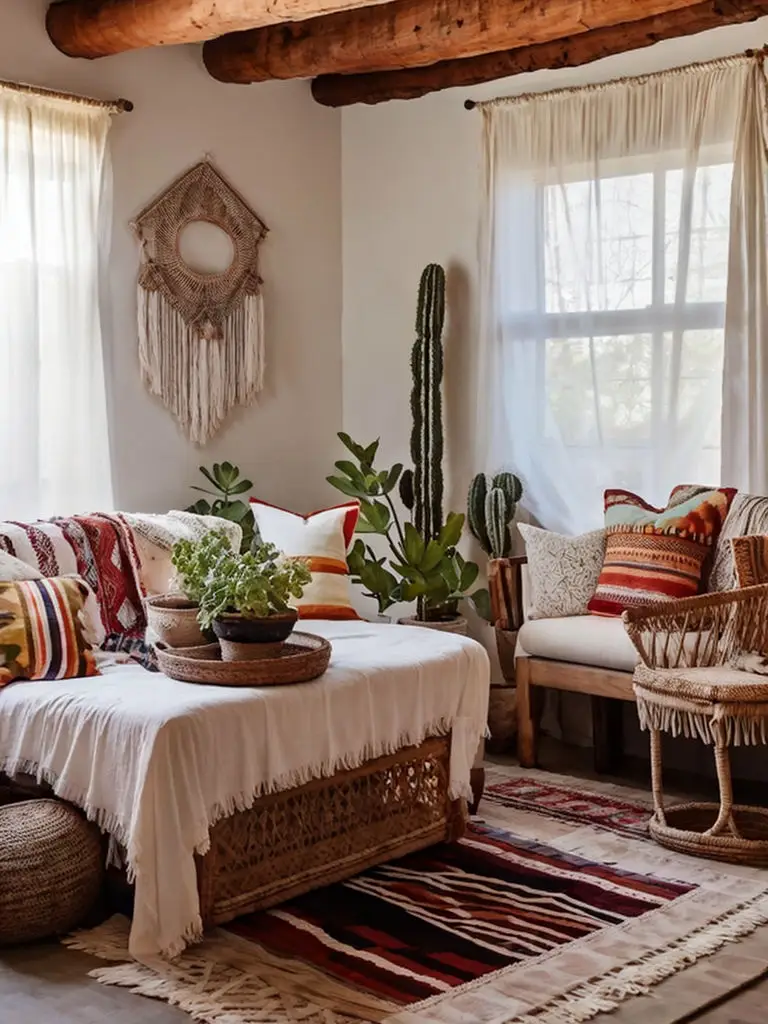
Adding Moroccan-inspired accents to your boho space can infuse it with exotic charm and vibrant, eclectic flair. Here’s how to integrate Moroccan elements effectively:
- Moroccan Poufs: Use Moroccan poufs as versatile seating or footrests. Their intricate patterns and rich textures can add a cozy, stylish touch. Place them in living areas, bedrooms, or as extra seating for guests.
- Moroccan Lanterns: Incorporate Moroccan lanterns to create a warm, inviting glow. Hang them from the ceiling, place them on side tables, or use them as centerpieces. Their intricate metalwork and colorful glass can enhance the boho aesthetic.
- Tiled Tables: Add a Moroccan tiled table, often featuring geometric patterns and vibrant colors, as a focal point in your space. Use it as a coffee table, side table, or even a dining table to introduce exotic flair.
- Moroccan Rugs: Layer Moroccan rugs with other patterns and textures to create a rich, boho look. The bold geometric designs and plush textures of Moroccan rugs can ground a room and add warmth.
- Textiles and Pillows: Incorporate Moroccan textiles like embroidered throw pillows, woven blankets, or colorful tapestries. Mix and match these with other boho fabrics to create a layered, inviting look.
- Decorative Trays: Use Moroccan-inspired trays for displaying candles, books, or small decor items. Their intricate designs can add a touch of elegance and serve as functional accents.
- Mirrors: Hang Moroccan mirrors with ornate frames to enhance the light and space in your room. Their decorative frames can add a touch of glamour and sophistication.
- Wall Art: Incorporate Moroccan-inspired wall art or tapestries featuring traditional patterns, vibrant colors, or abstract designs. This can serve as a focal point and bring character to your walls.
- Ceramic and Metal Accents: Add Moroccan ceramic vases or metal candle holders to your decor. These pieces can add texture and color, enhancing the exotic feel of your space.
- Mix with Boho Elements: Blend Moroccan accents with other boho elements like macramé wall hangings, natural materials, and vintage furniture to create a cohesive and layered look.
By thoughtfully integrating Moroccan-inspired accents, you can create a boho space that feels both exotic and inviting, filled with rich textures and vibrant colors.
7. Tassels and Fringe





Incorporating tassels and fringe into your decor is a great way to add a playful, bohemian touch. Here’s how to use these details to enhance your space:
- Tassel-Trimmed Pillows: Choose pillows with tassel trims in various colors and textures. Mix and match these with other patterned or solid pillows to create a layered, cozy look on your sofa or bed.
- Fringed Blankets: Drape fringed blankets over sofas, chairs, or the foot of your bed. The fringe adds a casual, relaxed vibe and enhances the bohemian aesthetic. Opt for blankets in bold patterns or rich textures to make a statement.
- Curtains with Tassels: Hang curtains with tassel or fringe details to frame your windows with a touch of boho charm. These can be particularly striking in lighter fabrics like linen or cotton.
- Tassel Rugs: Add a rug with tassel accents to create a focal point on the floor. Tassel-trimmed rugs can bring a sense of playfulness and warmth to any room.
- Fringed Lampshades: Choose lampshades with fringe details to add a touch of whimsy and style to your lighting. This can create a soft, diffused glow and enhance the overall bohemian feel.
- Tassel-Trimmed Throws: Incorporate tassel-trimmed throws on your sofa or armchair. They add a decorative element while also providing extra warmth and comfort.
- Fringe on Furniture: Look for furniture pieces with fringe details, such as a fringed ottoman or upholstered chairs. These can serve as unique focal points and complement your boho decor.
- Decorative Tassels: Use decorative tassels as accents on items like throw pillows, bed linens, or even as hangers for macramé wall hangings. They can add a cohesive touch throughout the room.
- Mix and Match: Combine tassels and fringe with other boho elements like macramé, woven baskets, or vintage furniture. This creates a layered look and keeps the space interesting and dynamic.
- Color Coordination: Ensure that the colors of your tassels and fringes complement the rest of your decor. You can use them to tie together different colors and patterns in the room.
By incorporating tassels and fringe, you can add playful, textural elements to your decor, enhancing the bohemian atmosphere and making your space feel more inviting and stylish.
8. Low Seating Areas




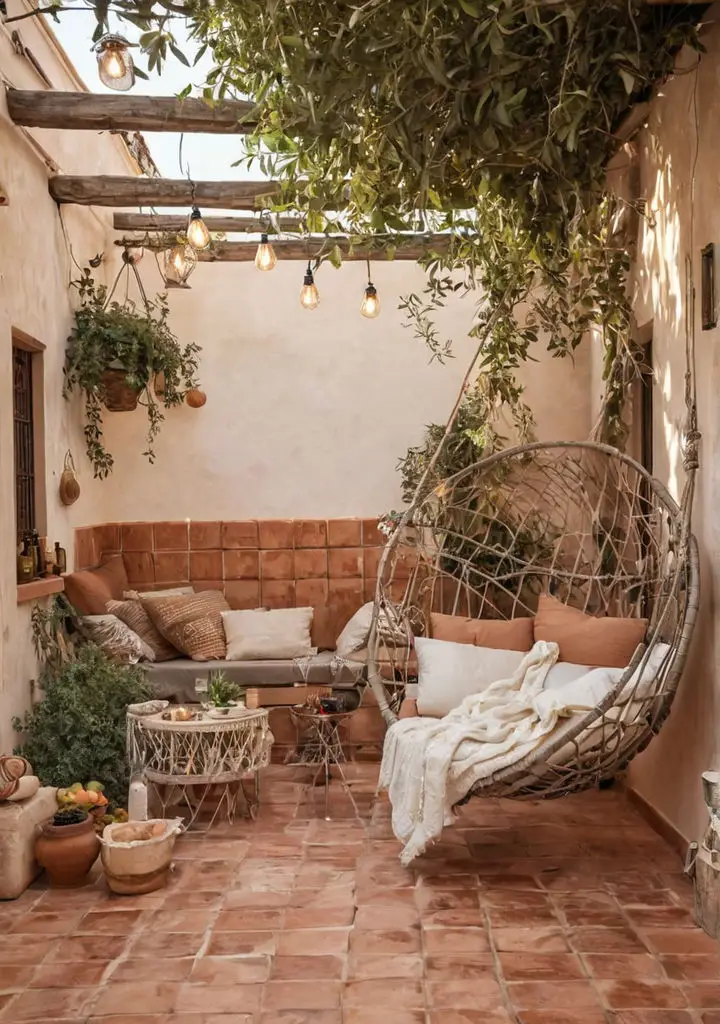
Creating low seating areas with floor cushions, poufs, and low-slung furniture is a great way to design a cozy, laid-back space. Here’s how to set up these inviting areas:
- Layer Floor Cushions: Use a variety of floor cushions in different sizes, shapes, and patterns to create a comfortable and casual seating arrangement. Arrange them around a low table or simply scatter them on the floor for a relaxed feel.
- Add Poufs: Incorporate poufs in your seating area for additional seating or as footrests. Poufs come in various textures and colors, making them versatile for adding comfort and style.
- Choose Low-Slung Furniture: Opt for low-profile furniture like low sofas, daybeds, or low coffee tables. These pieces help create a sense of openness and encourage a relaxed, informal atmosphere.
- Combine Textures: Mix different textures like plush velvet cushions, woven jute poufs, and soft cotton throws to add depth and interest to your seating area.
- Incorporate Rugs: Place a large, soft rug under your seating area to define the space and add warmth. Layer rugs for added texture and visual interest.
- Add Cozy Throws: Drape throws over cushions or poufs to enhance comfort and invite lounging. Choose throws in various textures and patterns to complement your seating arrangement.
- Use Low Tables: Pair your seating with low tables, such as a low coffee table or ottoman, to keep essentials within reach. These can also serve as decorative elements.
- Create a Floor Plan: Arrange your floor cushions and poufs in a way that encourages conversation and relaxation. Ensure there’s enough space for easy movement and access to the seating.
- Include Lighting: Add soft, ambient lighting with floor lamps or string lights to create a cozy, inviting atmosphere. Consider using lanterns or candles for additional warmth.
- Accessorize Thoughtfully: Add decorative elements like woven baskets, small plants, or low-profile side tables to enhance the aesthetic and functionality of the space.
By incorporating these elements, you can create a warm, inviting seating area that promotes relaxation and a casual, bohemian vibe.
9. Woven Baskets





Woven baskets are versatile and can enhance your space with both functionality and style. Here’s how to use them effectively:
- Storage Solutions: Use woven baskets to organize and store items like blankets, magazines, toys, or household essentials. They can be placed in closets, under coffee tables, or in open shelving units.
- Decorative Touches: Display woven baskets as standalone decorative pieces. Choose baskets with interesting patterns, colors, or shapes to add texture and visual appeal to your space.
- Plant Holders: Use larger woven baskets as planters for indoor plants. They can add a natural, rustic element and help to soften the look of plant pots.
- Laundry Baskets: Opt for stylish, woven baskets to serve as laundry hampers. They can blend seamlessly into your decor while providing a practical solution for laundry storage.
- Table Centerpieces: Place small woven baskets on tables or countertops as catch-alls for keys, fruit, or decorative items. They can also be used to hold candles or other small accents.
- Wall Art: Hang woven baskets on the wall in a pattern or arrangement to create a unique, textured art display. This can add depth and interest to blank walls.
- Entryway Organization: Use woven baskets in the entryway for storing shoes, hats, or scarves. They can help keep the area tidy while adding a touch of charm.
- Shelving Accents: Incorporate woven baskets into open shelving arrangements. They can store items out of sight while adding a layer of texture and warmth to the shelves.
- Bathroom Storage: Use small woven baskets in the bathroom for toiletries, towels, or other essentials. They can help keep your bathroom organized and stylish.
- Layered Look: Combine woven baskets with other materials, such as metal or wood, to create a layered, eclectic look. This mix can enhance the overall aesthetic of your space.
By using woven baskets thoughtfully, you can enhance both the functionality and aesthetic of your space, adding texture and a touch of rustic charm.
10. Driftwood and Natural Elements



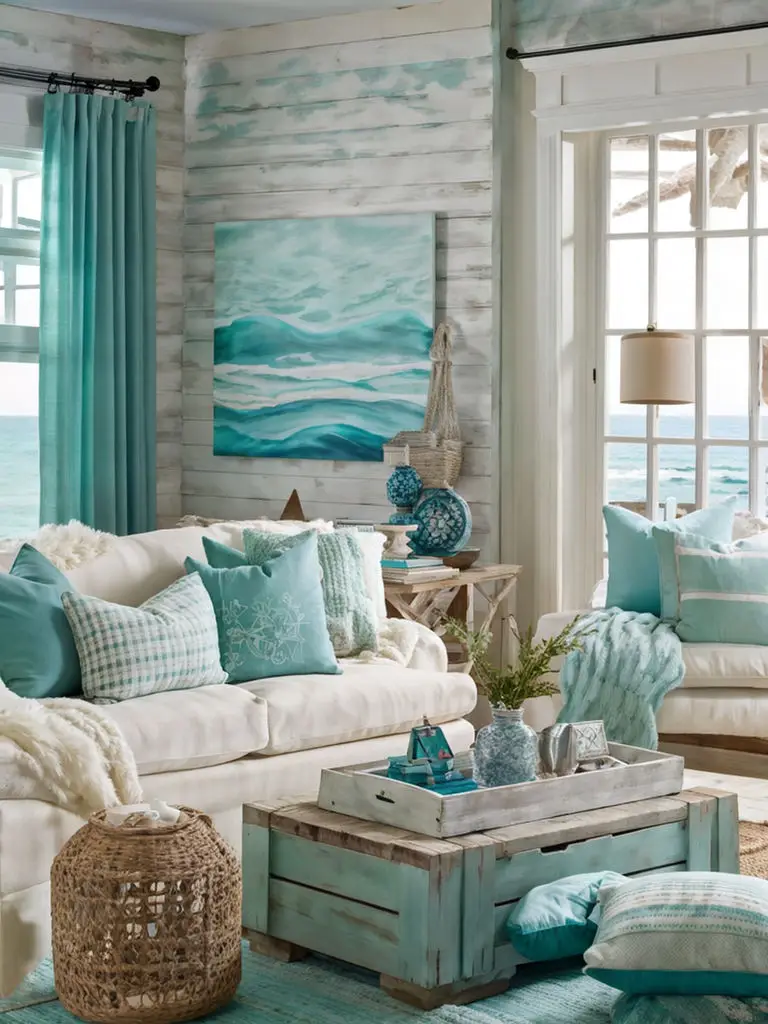

Incorporating driftwood, seashells, and other natural elements into your decor can create a serene, earthy ambiance. Here’s how to use these items effectively:
- Driftwood Displays: Use driftwood as a sculptural piece or centerpiece. Arrange it in a vase, place it on a mantel, or create a driftwood sculpture for a natural focal point.
- Seashell Accents: Incorporate seashells in various ways—display them in glass jars or bowls, use them as decorative accents on tables, or frame them in shadow boxes for wall art.
- Natural Centerpieces: Combine driftwood and seashells with other natural elements like pebbles or dried flowers to create unique and organic centerpieces for tables or shelves.
- Wall Art: Create wall art using driftwood. Arrange pieces in a pattern or shape and mount them on a canvas or directly onto the wall for a rustic, nature-inspired look.
- Table Decor: Use driftwood as a base for table arrangements or as a stand for candles. It can also serve as a unique base for decorative trays or dishes.
- Picture Frames: Craft or purchase picture frames made from driftwood or decorated with seashells. These can add a beachy, coastal feel to your photos or artwork.
- Natural Planters: Create or use planters made from driftwood or adorned with seashells. These can add an organic touch to your indoor garden.
- Coastal Accents: Combine driftwood with other coastal elements, like nautical ropes or vintage marine maps, to create a cohesive coastal theme in your decor.
- Seasonal Decor: Use driftwood and seashells to create seasonal decorations, such as beach-themed ornaments for summer or driftwood wreaths for different occasions.
- DIY Projects: Get creative with DIY projects, like making driftwood mobiles, seashell garlands, or driftwood candle holders. These projects can personalize your decor and enhance the natural vibe.
By thoughtfully incorporating driftwood and natural elements, you can enhance the earthy, organic feel of your decor, creating a space that feels connected to nature and inviting.
